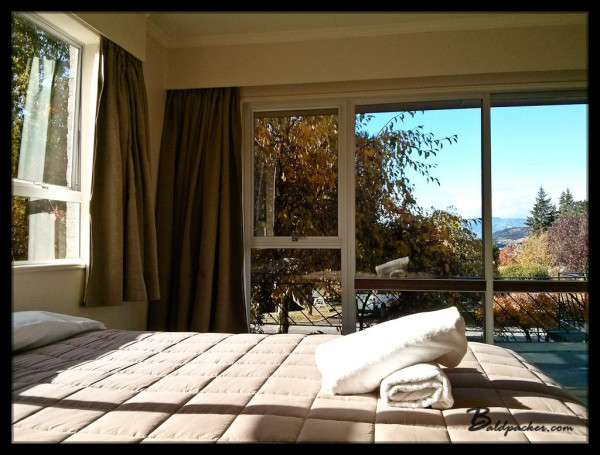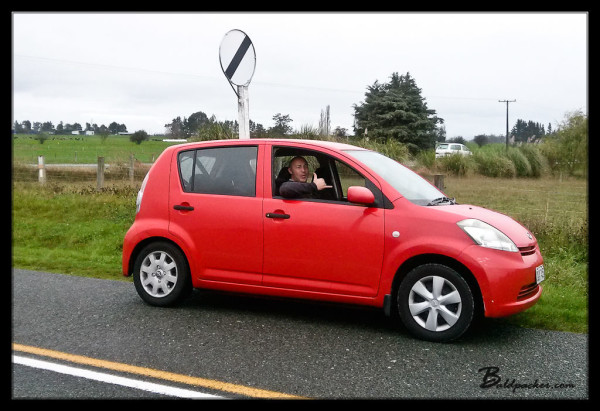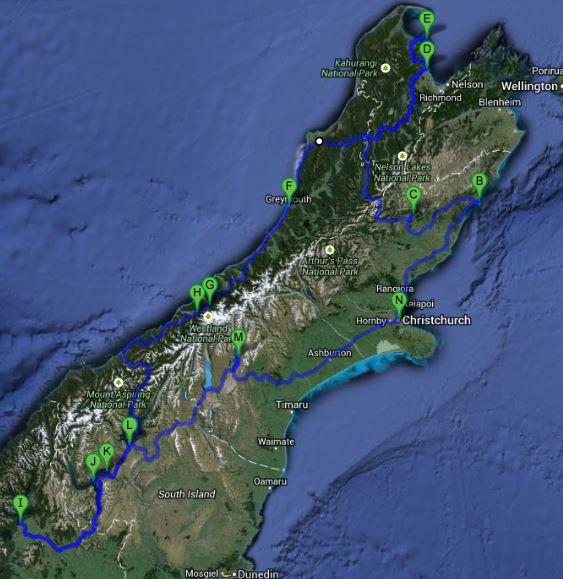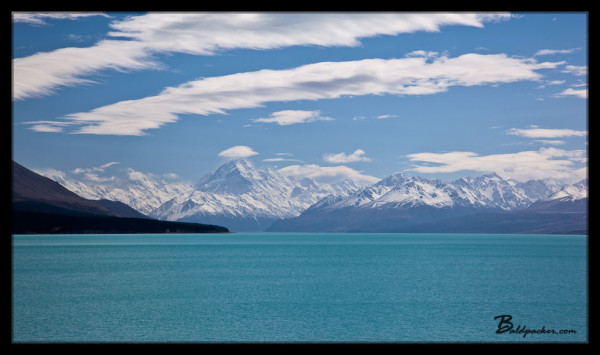
Guide to Road Tripping New Zealand’s South Island
I have now done two road trips through New Zealand’s South Island, each for approximately 3 weeks. The South Island of New Zealand is incredible and although I would not consider myself an expert, I have learned a lot over my trips and have summarized the main things you need to know to plan your trip below.
When to Visit New Zealand
Assuming your time is limited to a few weeks or months and you have the choice of when you visit New Zealand, the first decision to be made is what season to visit. I have been in New Zealand in both the Spring and the Fall and both had their positives and negatives.
Spring (Sept, Oct, Nov)
My first trip to New Zealand was in the spring of 2010 and it was certainly beautiful. The countryside is a lush green, trees are blooming, and the mountains still have snow which provide beautiful landscapes in the mountains. I was lucky enough to have generally excellent weather over my visit, but it is very common for light rain, cold temperatures, and even snowfall in early spring. Luckily, this variable weather also means good prices on airfares and car rentals and good accommodation availability.
The negatives are that the same snow offering the majestic views can greatly limit access to outdoor activities and there may be limited fresh produce available. The snow conditions for skiing begin to greatly decline but there is often still enough melting snow to prevent access to trekking and walking trails. As the snow warms up and new snow falls, there can also be an increased risk of avalanche and poor road conditions. In fact, during my Spring trip I ended up wasting several days trying to kayak in the Milford Sound after the highway was closed due to avalanche. Not fun!
Summer (Dec, Jan, Feb)
The weather in the summer is the best, making it the peak tourist season. The good weather makes it the best season to enjoy the beaches and boating, as well as hike the major tracks. There is also wonderful fresh fruit available such as Central Otago’s cherries and apricots.
The problem with traveling during peak tourist season is that things get busy! Airfares, rental cars, and accommodation will all be more expensive. Tourist stops and hikes will be busy and it may be difficult to enjoy the tranquility of New Zealand’s amazing nature.
Autumn / Fall (Mar, Apr, May)
Although I had irregularly wet and cold weather during my visit in the fall of 2014, I still thought it was an amazing time to travel. Our rental car was cheap and we had first pick of accommodation everywhere we went. Even though it was wet we still had access to all of the hikes we wanted to do and did not face any issues with road or trail closures. Further, the fall colours provided beautiful scenery, especially in the Queenstown, Central Otago, and Christchurch areas. Although the supply of fresh fruit was limited, we were able to purchase some amazing locally grown vegetables including tomatoes, potatoes, and zucchinis.
The only negative of the fall was the cold wet weather we experienced. I was told that we faced especially poor conditions in the 2014 so our experience was likely worse than normal, but it was still a drag. I would still suggest that for most people, the autumn is the best time to visit!
Winter (June, July, Aug)
The only reason I would suggest traveling to New Zealand’s South Island in the winter is if you want to ski or pursue other winter activities! Accommodation in most places (other than the ski resorts) will be cheap and with good availability, unless the place is closed altogether. In fact, many tourist attractions will be closed during the winter season so unless your focus is on winter sports, it is likely not the best time to road trip and sightsee. If you do drive towards the mountains in the winter, you will definitely need to carry snow chains and be aware of road conditions and should have experience with driving on snow and ice.
How to Get Around and Where to Stay
To me, transportation around New Zealand all depends on how many people there are, how long you have, and how deep your pockets are. If you’re a solo backpacker your budget will likely force you into cheap bus fares, flights, and tours, but this will greatly limit your ability to see New Zealand’s best sites which are often found between major towns and cities. Therefore, I would highly recommend trying to find other people to join up with to rent or purchase a car.
Unless you’re traveling for a month or more, I would highly recommend just renting a vehicle. In fact, unless I was planning on traveling for more than a couple of months I would probably rent a car. The reason for this is simply because of the hassles of buying and selling cars and the reliability concerns with such vehicles. In most cases, the vehicles bought and sold by backpackers are horribly maintained and you may end up facing high costs for towing and/or repairing such vehicles. After all, no one who is road tripping for a couple of months is going to go to the expense of changing the oil, replacing the tires, and other general maintenance. Beyond the reliability concerns, there are also serious safety concerns with such budget vehicles.
In renting vehicles, there are a few different options to consider: a) car rental; b) sleeper van rental; or c) motorhome rental. After much research and experience with renting both a sleeper van and a car I have decided my preference is by far to just rent a small car. On my first trip to New Zealand I rented a Jucy sleeper van because I expected it was the cheapest route to go.

After tallying the costs, I realized that it was actually more expensive than renting a car. The reason is that the cost of hostel beds or cabins in holiday parks are often only slightly more expensive than unpowered or powered tent sites. For example, cabins or hostel beds for 2 people are usually $50-70. Meanwhile, unpowered and powered tent sites are $20-40. This means a difference of between $10-50 per day. Once you factor in the increased cost of renting a sleeper van and the fuel (fuel is very expensive on the South Island), it is actually cheaper to rent a car and sleep in nicer accommodation than it is to rough it in a sleeper van. As an added benefit, it is far easier to drive and park smaller cars and they are often much more comfortable as well.

Would you rather sleep in a Queen Bed with Mountain Views for $60 per night or in a Van Site for $30 per night?
Some people are after the experience of sleeping in a van as they think it will be fun. I guess it is unique, but I wouldn’t say it is all that fun, especially in the Spring and Fall when the nights can be cold and the sun sets early. Unfortunately, once the sun has set, there is not a whole lot to do in a small cramped van. At least in a hostel or a cabin you have electricity and space to move easily. If you are in search of a more ‘outdoorsy’ New Zealand experience or potentially reducing your accommodation costs then I would recommend considering purchasing camping equipment – you can always pay to stay indoors if the weather is poor or you need a break from sleeping on the ground.
Although I have met some people who traveled New Zealand by ‘camping wild’ in vans or tents I would highly discourage it. It is not allowed in most areas and in my view it can be very unhygienic and potentially disruptive to wildlife and nature.
I will not discuss motorhome rentals at length except to say that they are very expensive. The rental cost is expensive, the overnight parking sites are expensive, the fuel is expensive, and they’re a hassle to drive, park, and maintain (water, waste, etc.). Even with a family my view is that it is much cheaper to simply rent a sedan and camp or stay in lodges or hostels along the way. If you’re willing to go to the expense of renting a motorhome it should only be for the experience of exploring New Zealand by motorhome.
In summary, unless you’re set on sleeping in a vehicle, renting a small car is the cheapest and most convenient way to go!

Things to Do
Adrenaline Activities
The Queenstown area is likely the most popular for adrenaline activities, but the whole South Island of New Zealand is renowned for things your mother does not want to hear about. Your options include bungee jumping, sky diving, jet boating, whitewater rafting, canyon swinging, mountain climbing, rappelling, paragliding, etc.
I have had the opportunity to pursue adrenaline activities all over the world, often for much cheaper than in New Zealand, but that is not to say the adrenaline activities in New Zealand are not well worth it. I did a 15,000 foot skydive in Abel Tasman and absolutely loved it. Research your options, stay safe, and have fun!
Outdoor Activities
Rather than spend money on adrenaline activities, I have found that some of New Zealand’s best treasures are free. There are hundreds of wonderful walks and treks available in all sorts of lengths and difficulties. If you know what you’re doing and the season is right, there are also opportunities to ski, snowboard, snowshoe, mountaineer, rock climb, surf, scuba dive, etc. In fact, New Zealand’s South Island may be my #1 spot for outdoor recreation in the world given its access to both mountain and sea!
Stargaze
New Zealand’s South Island has a population of only 1 million people, which means very little light pollution. In fact, residents in areas like Lake Tekapo have gone to great lengths to reduce the amount of light pollution in their skies which has allowed astronomers to perform research in the area.
Eat Lamb, Beef, and Farm Fresh Produce
New Zealand farmers and ranchers are rightfully proud of their products. Sheep and cattle are generally grass fed which means the lamb, beef, and sausages on offer are absolutely delicious. Many farmers also sell fruit and vegetables at roadside stands with honesty boxes, meaning you choose what you want and leave the appropriate money directly to the farmer. Many supermarkets also make a point of marketing locally grown products and I found it well worth the expense. Bon apetite!
Drink Beer & White Wine
New Zealand’s craft beer scene is wonderful, especially compared to what one finds in Australia. I tried a number of excellent beers during my time in New Zealand as well as a number of beer focused restaurants (my favourite of which is Pomeroy’s in Christchurch). Working in New Zealand’s favour is the fact that many excellent hop varieties are locally grown.
New Zealand is also well known for white wine, especially Sauvignon Blanc from the Marlborough region. Although I love the fruity, citrus sweet flavour of the Sauvignon Blancs, there are a number of varieties worth trying. Prices are reasonable, so indulge and enjoy!
Where to Go
The routes I took on my two South Island road trips are shown below:

Spring 2010 South Island Road Trip
In Spring 2010 my route was as follows: (A) Christchurch, (B) Kaikoura, (C) Hanmer Springs, (D) Motueka, (E) Totaranui / Abel Tasman, (F) Greymouth, (G) Franz Josef Glacier, (H) Fox Glacier, (I) Te Anau (could not get to Milford Sound due to road closure), (J) Queenstown, (K) Arrowtown, (L) Wanaka, (M) Lake Tekapo, (N) Christchurch.

Fall 2014 Road Trip
In Fall 2014 my route was as follows: (A) Christchurch, (B) Lake Tekapo, (C) Mount Cook, (D) Dunedin, (E) Waikawa, (F) Slope Point, (G) Colac Bay, (H) Lake Manapouri, (I) Te Anau, (J) Milford Sound, (K) Queenstown, (L) Arrowtown, (M) Wanaka, (N) Franz Josef Glacier, (O) Hokitika, (P) Arthur’s Pass, (Q) Christchurch.
Both routes had their own positives and I believe that in planning your route you need to consider the season and weather, how much time you have, how much driving you want to do, and the types of activities you want to do. Someone who is interested in adrenaline activities will likely want to spend more time in Queenstown than someone who is primarily interested in hiking.
For further information on each area, read my travel journals:

